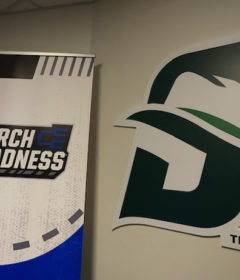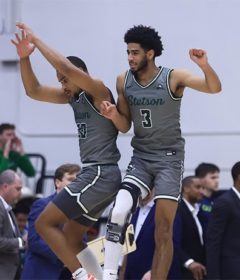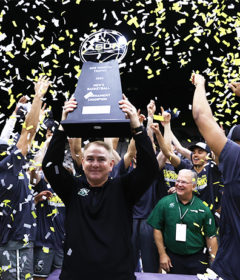Class of 2019: Shilpa Ravoory’s uncommon convergence of music and physics
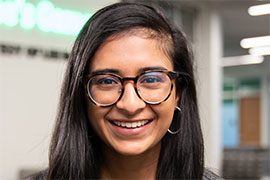
When Shilpa Ravoory arrived at Stetson from Ocoee High School near Orlando in fall 2014, her plan was to major in computer science and minor in music. It didn’t take long for her to make a resounding switch.
Playing the viola in recitals as a first-year student prompted Ravoory to make viola performance a major by that spring. (A viola is slightly larger than a violin and has a lower and deeper sound.) And, in the classroom, as she began to search for something different, physics came into focus, replacing computer science in fall 2015.
Fortuitous moves.
Ravoory paired the two seemingly disparate disciplines with uncommon success. She was principal violist of the Stetson Chamber, Symphony and Opera orchestras. Also, she was one of two winners during Stetson’s Concerto Competition in fall 2017, earning the privilege of performing with the Stetson Symphony Orchestra under esteemed professor and conductor Anthony Hose. More than two dozen other students had auditioned.
In addition, Ravoory was active throughout campus. She served as a FOCUS Leader, helping first-year students become oriented to Stetson; founded the Astronomy Club, which now has approximately 40 members; and participated on the executive board of Hatterthon, Stetson’s popular dance fundraiser for Arnold Palmer Hospital for Children in Orlando.
Essentially, she was able to embrace all that Stetson had to offer — with her passion for music helping to transform her personality.
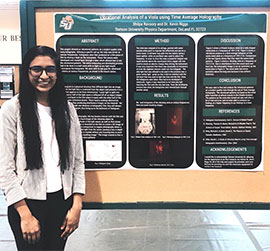
“I am not an introvert,” Ravoory said. “But music is way more creative, and physics is way more logical. The music brings out my creative side. I think I’m one of those extroverted introverts.”
“I get both sides [creative and logical],” she added. “And I get to experience the whole university, not just one area of campus.”
Actually, there is real convergence in music and physics, and Ravoory made it part of her Senior Project, where she analyzed the vibrational patterns of the viola using time-average holography. Just for starters on the project, Ravoory stripped the viola of its strings, brushed it with water-soluble white paint and placed it on a metal stand; a red laser was split into two beams using a beam splitter, while an oscillator was used to adjust frequency. Ultimately, holograms were taken of the vibrating viola at various frequencies, and she was able to find and analyze the vibrational patterns. The project was supervised by Professor and Chair of Physics Kevin Riggs, Ph.D.
“That was really cool, being able to connect the two [disciplines],” Ravoory said. “In general, you can connect the two in ways that a lot of people don’t realize.”
This fall, Ravoory will continue such exploration as she begins pursuit of a Master’s of Science degree in aerospace engineering at the Georgia Institute of Technology (Georgia Tech) in Atlanta, where she also will work as a graduate research assistant in an aero acoustics lab. In very basic terms, for example, aero acoustics can involve the link between the vibration of airplanes during flight and noise generation.
“I think I can build a lot of [professional] connections there, ” Ravoory commented about Georgia Tech.
Not that everything was long, smooth chord at Stetson.
One instance: While she ambitiously decided to double-major, there were other lessons to be mastered.
“I think the biggest thing was learning time management, and it took me about a semester and a half,” she said, pointing to early in her sophomore year.
Ravoory credits faculty members in both major areas of study for supporting her at every turn, particularly Associate Professor of Music Jesus Alfonso, D.M.A. “He’s not only been a great professor, but also very understanding [of my time, given the obligations of the second major],” Ravoory said.
In the end, Ravoory believes she hit just the right note by deciding to attend Stetson. Initially, she was attracted by a “pretty” setting that was small enough to provide personalized attention. Those attributes held true throughout her time on campus.
“I was able to walk into a professor’s office and ask for help at any point,” she concluded. “Every time I did that I realize Stetson was the best school for me.”
-Michael Candelaria

